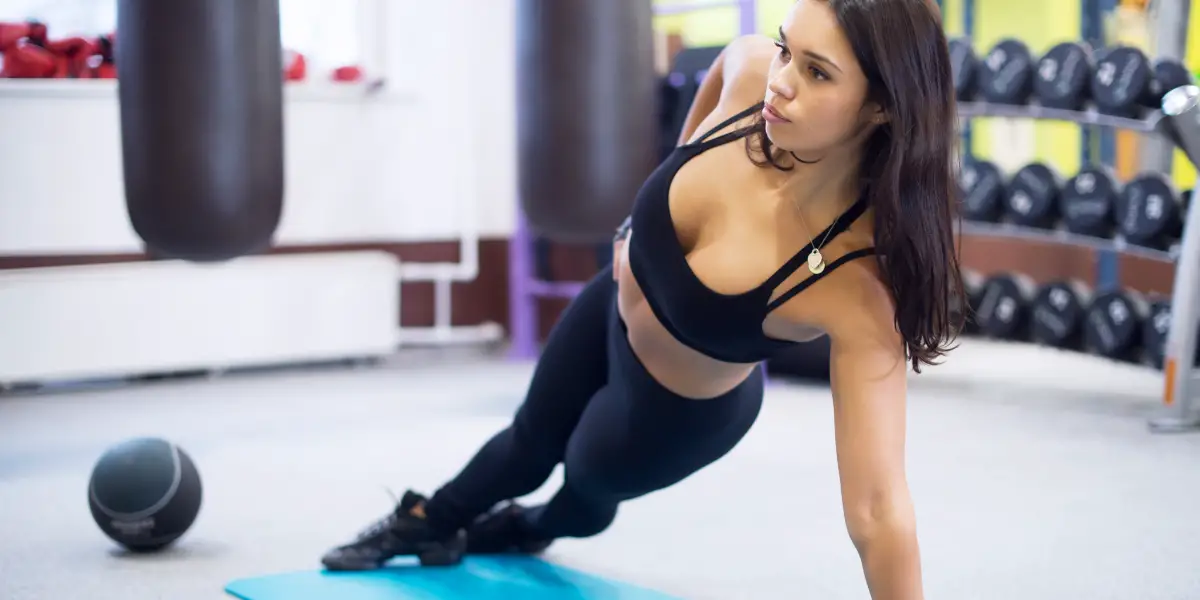Perfectly poised in a side plank, you’re not just sculpting your silhouette but also stepping up your flexibility.
This seemingly simple exercise stretches and strengthens your oblique abdominal muscles alongside your gluteus medius and maximus.
The side plank is more effective for building strength in your core muscles rather than improving flexibility. While it does engage your muscles and can help with stability, adding stretches specifically targeting flexibility is recommended for overall flexibility improvement.
As you hold the position, you’re enhancing the elasticity of the muscles around your hips and core, which can improve your range of motion.
Regularly incorporating side planks into your routine can lead to greater flexibility, contributing to better posture and smoother movement in your daily activities.
While it’s not a cure-all for flexibility, it’s a powerful part of a balanced workout that targets those often-neglected side muscles.
So, if you’re looking to bend but not break, the side plank is a steadfast friend.
Understanding Side Plank Mechanics
To master the side plank, you’ll need to maintain proper form by keeping your hips aligned atop one another, ensuring they don’t sag toward the floor.
This movement is one of the most effective core exercises, targeting not just your oblique abdominals but also engaging the primary muscles used for a solid core.
Your body should form a straight line from head to feet, with your hip and shoulder directly above each other. If you’re starting out, consider the remedial side plank position to build up your Trunk Muscle Activation gradually.
Remember, core stability training is a marathon, not a sprint. The side plank is your ally, working the gluteus medius and gluteus maximus alongside your core, fortifying your body’s foundation for every physical challenge ahead.
Keep pushing!
Side Plank’s Flexibility Benefits
Building on your core stability with side planks, you’ll also enhance your flexibility, particularly in the shoulders, obliques, and hips, as these muscles stretch and strengthen simultaneously. Recognize the side plank as not just a core stabilizer but a key player in your flexibility regime. Here’s how it elevates your movement range:
- Oblique Muscles: Side planks work wonders for strengthening the oblique abdominal muscles, which in turn aids in twisting and bending side-to-side motions.
- Hip Flexibility: The involvement of the gluteus medius and maximus supports hip motion, contributing to better hip flexibility.
- Shoulder Stabilizers: As you balance, the shoulder stabilizers engage, promoting shoulder health and range.
- Integrated Movement: Every lift and hold improves the fluidity of your overall movement.
Stay motivated, and incorporate the side plank into your routine for tangible flexibility benefits.
Incorporating Side Planks Safely
Ensure you’re performing side planks correctly to maximize their flexibility benefits and minimize the risk of injury. To safely incorporate this potent exercise into your routine, start with modified side planks, especially if you find maintaining the full position challenging.
Position yourself on your knees, keeping your hips stacked and facing forward for proper form, which is crucial for core stabilization and to effectively strengthen the oblique muscles and shoulder stabilizers.
Avoid letting your hips sag, as this can lead to strain injuries. Remember to relax your face and the hand supporting your body to release any unnecessary tension. If you experience shoulder, arm, or core pain, steer clear of side planks to prevent exacerbating discomfort.
Gradually increase your hold time as your strength and flexibility improve.
Common Side Plank Misconceptions
Despite some common myths, you shouldn’t hold a side plank until your form suffers, as it’s more effective to stop when you start to shake or lose alignment. Here’s the real deal on side planks and flexibility:
- Misconception: Longer is always better.
Truth: Quality over quantity; maintain correct form. - Misconception: The exercise doesn’t put pressure on the oblique muscles.
Truth: Side planks specifically target and strengthen obliques. - Misconception: If your hips sag, it’s not a real issue.
Truth: Proper form requires the gluteus medius and maximus to prevent hip sagging. - Misconception: Adding complexity means touching the ground.
Truth: Maintain tension for core stabilization without compromising alignment.
Enhancing Flexibility With Variations
Incorporating variations into your side plank routine can significantly boost your flexibility by challenging different muscle groups.
By engaging your oblique muscles through side plank dips, you’re not just strengthening your core, but also promoting flexibility in your hips and knees. Add rotations to target your lat muscles and abs, further enhancing your range of motion.
Elevate your side plank to shift the emphasis to your shoulder, increasing upper body flexibility. Utilize a stability ball to introduce an element of instability, which requires more core stabilization and activates both your gluteus medius and gluteus maximus.
Embrace the complexity of a side plank reach-through or an up-down movement. These variations add a dynamic component to your exercise, pushing your flexibility to new heights. Keep challenging yourself, and watch your flexibility improve.




